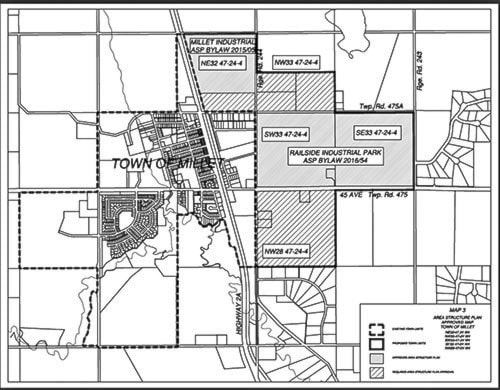The proposed annexation of land from the County of Wetaskiwin to the Town of Millet has passed the public and municipal government stage, and is now in the hands of the Municipal Government Board (MGB), which will make its recommendations to the Minister of Municipal Affairs.
A hearing in which representatives from the Town of Millet and the County of Wetaskiwin presented their proposal in detail to the MGB was held March 1 at the Millet Agriplex.
The Town of Millet is proposing to annex 665.91 acres from the County of Wetaskiwin. If approved, it is scheduled to come into effect Jan. 1, 2018.
Members of the public were also given a chance to speak during the hearing. About a dozen people were in the audience.
One main concern was contaminated runoff affecting low-lying land. “Currently under our sewer regulation bylaw we do have provisions for monitoring, as well as the steps to be taken,” town CAO Teri Pelletier.
Another concern was whether utilities would change. A ratepayer with a letter stating FortisAlberta has made an application to replace Battle River REA as the utility provider for the Battle River area, with the annexation as the reason, came to the hearing looking for answers.
“It’s a blanket application,” said County of Wetaskiwin CAO Frank Coutney. He explained FortisAlberta could make the application without the proposed annexation.
The Town of Millet has a utilities franchise agreement that would apply to the annexed area. “The County of Wetaskiwin does not have franchise fees at this point,” said County of Wetaskiwin reeve Kathy Rooyakkers.
“It is the Town of Millet’s intention that nothing will change with the proposed annexation until one of three things occur,” said Pelletier.
She was referring to change of permitted use of annexed lands under the land use bylaw, a subdivision is proposed or there is a request to connect to municipal services.
Pelletier added roads will be maintained to county standards, including snow removal and capital projects will be adopted into the town’s capital project process.
According to the annexation application — which can be found on the town’s website — “Currently, the proposed annexation area does not have municipal water or sewer services. Once it is annexed, the area can be serviced and increase its potential for future development of commercial and industrial. There will be a cost to connect to these services and an offsite levy will apply.”
“The Town of Millet will allow water wells and sewage systems that have been approved,” said Pelletier. Landowners can connect to municipal services but are not obligated.
The Town of Millet became a member of the Capital Region Southwest Water Services Commission in 2015, and the waterlines for Millet are scheduled to be commissioned March 20, 2017, says Pelletier.
During the hearing the MGB questioned and confirmed for itself the driving force behind the proposed annexation is to provide more industrial land.
Also listed in the annexation application are goals of the annexation: establish an industrial area that will foster job growth in a non-intrusive manner, secure potential employers that will build on Millet’s vision and be a leader in providing regulatory guidelines with respect to industrial operation.
Both the town and county are members of the Joint Economic Development Initiative (JEDI) agreement.
Rooyakkers says the agreement, designed in 2003, allows the partners of JEDI (which includes the City of Wetaskiwin) to simplify and further industrial growth in the region, and allow the municipalities to share in a “unique” collaborative economic agreement.
“We believe this annexation has been facilitated by the agreement known as the JEDI agreement,” said Rooyakkers.
Coutney informed the MGB the county is not seeking compensation from the Town of Millet for the annexation.
The JEDI agreement states tax revenue from industrial land developments registered and developed after 2006 are shared between the three partner municipalities, regardless of the development’s location. Tax revenue from developments are distributed between the municipalities based on the proportionate populations.
There are also a handful of residential properties included in the annexation area.
“The county fully supports the annexation,” said Rooyakkers. “The county believes the annexation is a positive step forward for the landowners included.”
